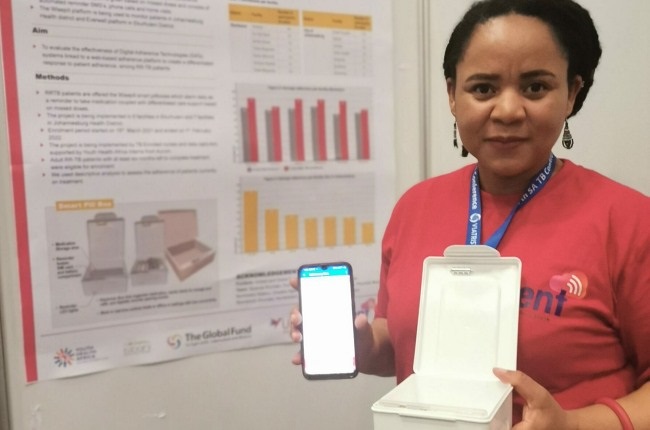
- There are many reasons why someone might stop taking TB treatment or skip doses.
- One way in which people with TB can supported is through Digital Adherence Technologies, which include smart pill boxes.
- However, one TB survivor and activist says that pill boxes on their own won’t solve the problem.
Tuberculosis (TB) can be cured, but completing TB treatment can sometimes be difficult. Treatment for drug-susceptible forms of TB takes six months and some of the medicines have side effects. Treatment of drug-resistant TB typically takes more than six months and the risk of side effects is substantially higher.
There are several reasons why someone might stop taking treatment or skip doses. In some cases, the side effects may be so severe that people decide to stop taking the medicines. In other cases, people may feel healthy after just a few weeks of treatment and find it hard to stay motivated to keep taking medicines for the remainder of the six months treatment course.
One way in which people with TB can be supported is with what is called Digital Adherence Technologies, or DAT. As explained by Nontobeko Mokone, study coordinator at the Aurum Institute (an NGO), there are different types of DAT, including smart pill boxes, video support, and 99DOTS. (99DOTS is a form of mobile phone-based treatment adherence tracking where people place a free call to a phone number that is only revealed as pills are removed from their packaging.)
READ MORE | In-depth: Use of urine test for TB increasing
A World Health Organization (WHO) Handbook for the use of digital technologies to support TB treatment and adherence states that adherence support technologies should be part of an integrated approach complementing the delivery of quality care. Although the WHO recommends the use of DAT for TB treatment, they also state that more studies and evaluations on the feasibility and utility of DATs in programmatic realities are needed.
Dr Amera Khan, TB Reach and Technical Officer at the Stop TB Partnership tells Spotlight that DATs are tools designed to support people with TB in taking their medications. For persons with TB, Khan says, it is very important that they take all their medications for them to get better and to ensure that they do not develop drug resistance.
“The tools are designed to remind people to take their treatment and they also record when a person takes a dose. This allows their healthcare provider to know if they are being adherent to treatment or if they need additional treatment support. Compared to traditional directly observed therapy (DOT), where people with TB are observed by a healthcare worker or a community or family member when they take their pills, the tools allow for a person-centred care approach to TB treatment – they allow for people to take their medications at a time and place that is convenient to them while remaining connected to their healthcare provider,” says Khan.
Some, like Phumeza Tisile, extensively drug-resistant TB survivor and activist, however, express unease with this kind of remote monitoring of patients and point out that it is not done for people with other diseases.
The smart pill box
One form of DAT that is being used in South Africa is the smart pill box. Mokone explains that the smart pill box is a medication container that has an electronic module that works in real-time to record box activities on a web-based platform.
“The box has a unique serial number that helps link the patient to the device and to the adherence platform. A healthcare worker is then able to open a calendar from a cell phone, laptop, or computer to view a patient’s adherence activities daily. There is an alarm that is set to remind patients when it’s time to take their medication,” she says.
The box is fitted with different lights – green to indicate it is time to take medication, yellow to indicate that a refill is needed, and red to indicate that the battery is low.
READ MORE | Tuberculosis: SA’s ‘easily forgotten’ killer needs the same investment Covid has received - experts
Based on calendar activities, Mokone says they can see if the patient is doing what they were educated to do. That is to open the box at the same time daily for a short period of time. “The opening of the box should be sufficient to allow for blister pack opening and drinking the medication. Then the system will record a dose taken. A single missed dose reflects red on the calendar and the system sends an automatic SMS reminder,” Mokone says.
Of course, confirmation that the box has been opened is not confirmation that the pills were actually taken, but Khan says “some accuracy studies which have used urine analysis have indicated that generally if the box has been opened it is likely that the person has taken their dose”.
“If two doses are missed, then a phone call will be made to the patient to find out if all is well and if they are not having challenges,” says Mokone. “If [there are] three or four missed doses, a home visit is conducted to check if the patient is well. Then counselling is initiated where issues relating to non-adherence are observed. This is the time where other socio-economic issues can be identified and the patient is referred accordingly.”
READ MORE | What is government doing to restore TB services?
If the box stays opened and unattended for a long time, Mokone says the system will show activity but not record a dose. “The battery will get depleted much faster as the system tries to send non-stop pulses. This is observed on the platform as all activities get recorded there. The patient will be contacted to find out if the box is not malfunctioning and then education on box handling will be given to the patient where required,” she says.
“For many people on TB treatment, the smart pill boxes can be a more convenient treatment adherence option that fits into their lifestyle compared to traditional DOT. While much has been learned about using and implementing these tools, I think we are continuing to learn how to improve the use of these tools to ensure that people on treatment are also getting the additional treatment support they need.
"Whether it be psychosocial, economic, or nutritional. For scaling we also need to think about digital health equity – how we can expand the use of these tools to some of our most vulnerable populations affected by TB who may not have good network access to use these tools to their full capacity,” says Khan.
The Ascent project
Mokone says the Aurum Institute, as part of the five-country Ascent project, has been providing smart pill boxes in five districts in South Africa – Bojanala, Tshwane, Cape Town, Ekurhuleni, and Johannesburg. The project started in February 2021 and 2 225 boxes have so far been distributed to different health facilities in South Africa. Mokone presented early numbers from the project at the South African TB conference recently held in Durban.
“After the initial distribution of boxes, some of them had to be re-used for other patients leading us to a total of 2 773 patients enrolled; 67% were males. The participation rate was 90% across all districts, with an average adherence of 90% on patients supported with the smart pill box,” says Mokone.
An original goal of reaching 16 000 people in two years had to be reconsidered in light of Covid-19-related disruptions.
READ MORE | Tuberculosis, the forgotten pandemic relying on a 100-year-old vaccine
Fezeka Mboniswa, a study coordinator at the Aurum Institute, says they enrolled 191 patients in a smaller study of the smart pill box in Cape Town. The aim of this study was to evaluate the effectiveness of DATs systems that are linked to a web-based adherence platform to create a differentiated response to patients adherence combined with a psychosocial intervention among RR-TB patients (RR-TB is TB that is resistant to the drug rifampicin).
Mboniswa explains that 173 people received both the box and psychosocial support while the remaining 18 only received the box.
“Preliminary results show that DATs combined with psychosocial support can improve adherence amongst RR TB patients,” says Mboniswa. The data is however still being cleaned and no data quantifying the extent of the claimed improvement have yet been published.
Human interaction
Despite the new technologies, human interaction remains at the core of patient support when it comes to TB management, according to Mokone.
“There are many factors influencing adherence to TB medication which cannot be addressed using the box only. The box provides a basis for prioritising patients according to their needs. Some patients require psychosocial support, some need to be heard, and others need to be cheered on during a very lengthy treatment duration. This can only be provided by healthcare workers and the DATs allow them to know who needs additional attention well on time,” says Mokone.
Mboniswa says psychosocial support is a crucial component of treatment for TB patients, especially patients with DR-TB.
Wider use of smart pill boxes and increased psychosocial support for TB patients is, however, likely to depend on funding. “If funding is available, social workers will be roving in all TB facilities to assess TB patients and provide additional support,” says Mboniswa. “Patients with Psychosocial problems will be identified, and necessary referrals will be done.”
Not for everyone
Tisile stresses that pill boxes on their own won’t solve the problem and should be part of comprehensive care, including counselling.
“Although these are somewhat improved ways of direct observation therapies, I’m still very much uncomfortable. I still struggle to understand the need for TB patients to be monitored when taking their medication. I do not know of any other disease out there that does the same thing. The only way we can improve treatment adherence is for new TB patients to have support from the first stage of care. The patients should be well informed about their TB diagnosis and what to expect, etcetera,” says Tisile, adding that counselling should be mandatory for all new TB patients.
READ MORE | Editorial | How do we make an HIV and TB plan that has greater impact?
Tisile says in South Africa we have cities and rural areas. “Are these new technologies that are being introduced good for everyone? In the rural areas, it is even hard to get a mere mobile data connectivity or even make a call. There’s a slogan that is usually used in the health sector which says leave no one behind. What does this mean for those with limited resources?” asks Tisile.
Mokone says the smart pill box is a supporting tool. “It is meant to provide support to patients, not to police them. “That is why extensive counselling is provided before the box is issued. Patients have to understand that the biggest responsibility lies with them. They must drink their medication to fully recover from the TB disease, otherwise, the box will not assist them,” she says.
*This article was published by Spotlight – health journalism in the public interest.




 Publications
Publications
 Partners
Partners











